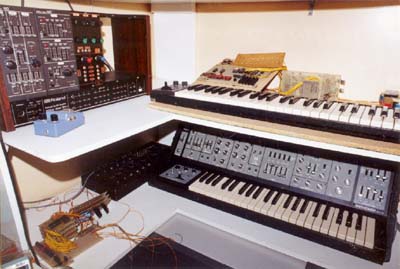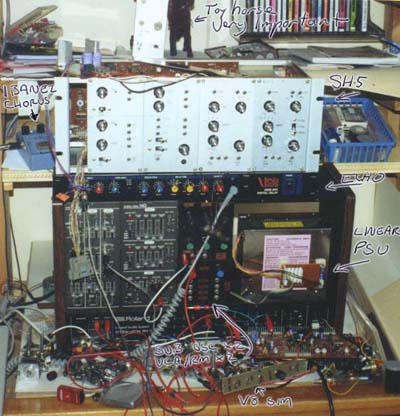|
Introduction
I have been working on this synthesizer for many years. In fact, I started when analog synthesizers were still being manufactured. Now they are considered "vintage". As far back as I can remember, I've loved electronics, and somewhere in my childhood, music and electronics got crossed. Unfortunately that other key ingredient, money, was hard to find.
Much early experimentation was done on protoboard with a handful of CMOS chips picked up for 25c each when Tandy (Radio Shack) cleared their stock. Progress was difficult - my father thought there was no future in electronics, and didn't make it easy for me to pursue my hobby, with a couple of notable exceptions - a "50 in 1" electronics kit, then many years later some other equipment.
This equipment consisted of a portable Yamaha organ, Hohner Pianet, Mini Pops rhythm unit, Carlsbro Marlin Amplifier, Suzz and Flanger effects pedals, and a massive custom speaker box, all bought through the local trading post newspaper. The down side was I was expected to play these instruments to entertain old folk on various occasions. Fortunately this soon ceased. I'm no performer. (Years earlier, with only three months of musical training, I was playing Lowrey organs for Brashs, center court, Southland, a major shopping center at the age of 12 - go figure.)
A year or two later, late 1980, my father's final (and best) electronic music gift was given. According to his instructions I was allowed to organize myself the absolute minimum synthesizer system (these things were expensive!), something I'd wanted ever since I saw a Minimoog demonstrated at school in 1974.
Much researching later, I settled on the Roland 100M modular, specifically, one 110 VCO-VCF-VCA module, one 140 2 ENV-LFO, one 191J 5 module system rack, and the 181 49 keyboard controller. Remember, I said absolute minimum. I should have asked for a 172 Phase shifter/audio delay/gate delay too. The idea was I would fill the rack when I could afford to.
Unfortunately, by the time I could afford to buy more modules, they were no longer available, and I never did find any for sale second hand. Now they are collectible, and again are way too expensive for me to purchase.
One time years later, I thought I had found one for sale. $395 for a "fully optioned" system - all available modules. I had arranged to go around and look at it, when I realized it was the System 100, not System 100M that was being sold, so I canceled. The poor guy was heartbroken. He just couldn't get rid of the thing! Now if only I could wind back the clock. People are asking four to five times as much now. I wasn't really into synths at that point, spending more time with computers.
Back in 1981, while trying to expand the System 100M the hard way (D.I.Y.) I was standing in an electronics shop with the International 4600 book under my arm when approached by another man asking if I had trouble getting my VCF's to work. I hadn't built any of the 4600 by that stage, but we got talking. This fellow, Rick, had built himself a truly impressive 4600 system. His work was immaculate, and if only one 4600 built ever worked, this would be it. Sixteen years after last using it, I have finally seen this unit again. It contains 8 VCO's, 5 VCF's, and at least twice as much of everything else as specified in the 4600. When I last used it, no keyboard had been built, but there was one of the ETI sequencers, and I had many hours of fun with this machine. See Rick's modular for more info on this spectacular unit.
What was the fault with the filters? In later runs of the PCB made for the kit supplier, a short piece of tape had fallen from the PCB artwork. This piece of tape ran between two curved tracks about mid point, bridging a small gap. The two curved tracks looked quite correct without this join between them, making it a very hard fault to trace. I never found it. Another of Rick's friends did work out the PCB was at fault and got the filters running. It wasn't until years later when I purchased a partially completed 3800 that I was able to compare the PCB artwork and realize what had happened. Why couldn't I compare with the art given in the construction article? I guess there were two reasons, that I never suspected the PCB to start with, and because the kit PCBs used different artwork for that module.
My early efforts at building modules were not all that successful. Home etched PCBs left a lot to be desired. Initially hand drawn, I later started using layout tape and photosensitized boards, but it's a messy job. Several VCA's and mixers were built, one of which also functioned as a four step sequencer. Noise sources were also made. The first module used a sheet of 1/8 inch thick cardboard as its panel! The second and third used sheets of copper. The third, which probably uses parts of the first, still exists as part of the system. It also includes a pair of sub oscillators I designed, the circuit for which was published in ETI "Ideas for Experimenters" in the early eighties.
Another module was constructed on a rack mount panel, of which I can find no trace, though I believe I still have some parts of the original circuit board. Some of these have been rebuilt in the current format, and others still wait.
Some "rack mount" modules were attempted, including the Formant ADSRs, though these were not finished at the time, and some E&MM modules (effects rather than synth modules) though these have long since expired.

The setup in Feb 1985 At some point I purchased a Roland SH5, complete with circuit diagrams. When I connected it up to the other modules, I found out it didn't track 1 volt per octave! Retuning it I found the other fault - inaccurate H/M/L octave switching for the keyboard now was spot on. Unfortunately, the pots went noisy, and there was no curing them. Eventually, after trying for weeks to sell the thing for $100 without a single inquiry, I gutted it and disposed of the case, as I was tired of tripping over it. I literally had nowhere I could keep it. The remains lived in a small cardboard box in the "cellar" (a small area I had dug under the house) for many years. I picked up another SH5 for a friend years later - selling it to him for $50. Only a couple of years later these have the price tag of over $1000. Around this time, I converted part of my SH5 remains to modular format. Time has eroded the list of equipment from the original purchase, and only the flanger remains, the amplifier and speaker being the last to go when I moved house.

The converted SH5 during its rebuild, and revived 100M in June 1997. A couple of years ago, when I discovered others on the internet shared an interest in vintage analogue synths, the System 100M and the bits and pieces were retrieved from the cellar. Pots were cleaned or replaced, panels were made for circuit boards, power supplies were rebuilt. All fired up okay. Of the SH5, the VCF/VCA/BPF module was rebuilt to fit into an empty space on the System 100M. Most of the rest of the very un-modular design has been built into a rack mount case. Other modules have been rebuilt into "Moog style" panels, though panel artwork has varied somewhat, trying to emulate CMS, Buchla, then finally settling on my own style. Backgrounds went from black to silver, then pale "Buchla" colors to white, then the rather garish sunburst. A few other "artistic" panels earned the system the name "the catgirl synth" from other synth-DIY members. I no longer have access to the printer I used to make these panels, so time will tell what I do next, though I do have a few colorful "blanks" in reserve. Some new modules have been built too, including tube based modules, Wave tables, a couple of MOTM modules and quite a few new ones of my own design, for which I now sell PCBs. New cases were built by my father to my design, replacing the old case, which was in fact a mobile shelf rack from a pasta shop (no kidding!). The new case is in six sections, each of which will hold two 5U racks. The panels are at an angle, and there is enough depth to hold low profile power supplies rack mounted at the back. When assembled, they are remeniscent of "Tonto". Lacking at the moment is a decent sequencer. The existing sequencer was built into a most unsuitable case using surplus car radio pots for which I can get no knobs. It is also completely hand wired, based on the ETI design. There's nothing wrong with it electronically. In fact some of the circuit adaptations are pretty neat. It's just a pain to put anywhere and to tune the very weird "exponential" surplus pots. Of interest is that much of what I build costs me very little. Panels are made from aluminium sheets that someone was throwing away. Many knobs came from a mixer that had been left out as rubbish. Many components are salvaged from old circuit boards, or taken from my substantial stock of old parts collected over the years. I enjoy recycling old parts. I enjoy the challenge of getting things going without having to go out to a shop to buy parts. Building a vintage synth using "vintage" components seems fitting. So maybe this doesn't sound like the sort of synthesiser you would want in your studio. Well, I'm not in a studio, nor do I ever expect I will find myself in one. I'm doing this for fun. Like me, I'm sure there are people who are building and playing these things entirely for their own enjoyment. And like me, there will be people who wish to build them but can't afford the expense of upmarket kits. Article, art & design copyright 1999-2002 by Ken Stone
|